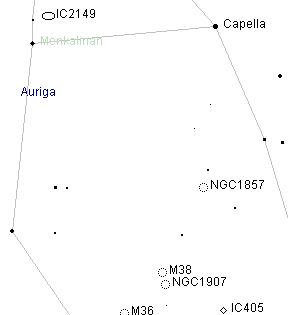Avoiding the Obvious in Auriga
Jack Kramer
Most observers are familiar with the open clusters M36, M37, and M38 in Auriga, but let's avoid them for now. Right nearby are other objects of interest that may be overlooked because of proximity to their bright neighbors.
Starting at the south is IC 2149, a 10th magnitude planetary nebula. With an Oxygen III filter on my 10" scope, a small, oval glow of nebulosity is seen. Without the filter, a star appears in this spot. Is this the central star that blew its brains out to give us a planetary nebula?

Moving north, we come to NGC 1857, a modest-sized (6'), loose open cluster containing stars of about 8th magnitude strewn fairly evenly about the field.
Some observers have probably looked at M38 and not realized that just to the north is another cluster, NGC 1907; while not as bright, it offers more of a challenge. It's not difficult, though. My notes indicate it first appeared as a patch of nebulosity, but on careful inspection with the 10", it showed a rich concentration of stars of about 10th magnitude. In my old 70mm copyscope, it looked like a small, luminous ball, with ten stars discernable.
A little farther north is IC 405, the "Flaming Star" nebula that surrounds the variable star AE Auriga. Of the objects cited here, this is the most difficult. Observing from New Mexico, it became visible with an Oxygen III filter in the 10" as a large, faint, formless glow.
Published in the January 1997 issue of the NightTimes




